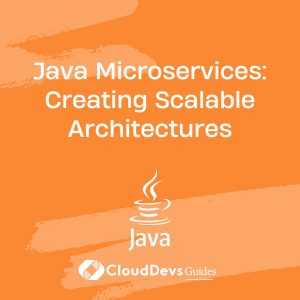Java Microservices: Creating Scalable Architectures
In the fast-paced world of software development, building scalable architectures is paramount to meeting the demands of modern applications. One approach gaining popularity is the use of Java microservices, a methodology that breaks down applications into smaller, independently deployable services. In this article, we’ll delve into the world of Java microservices, exploring what they are, their benefits, and how to create scalable architectures using them.
What are Java Microservices?
Java microservices are a way of architecting applications as a collection of small, loosely coupled services. Each service is designed to perform a specific function, such as user authentication, data processing, or payment processing. These services communicate with each other through well-defined APIs, often using lightweight protocols like HTTP or messaging queues.
Benefits of Java Microservices
- Scalability: One of the primary benefits of Java microservices is scalability. Because each service is independent, it’s easier to scale individual components of an application based on demand. This means you can allocate more resources to critical services without having to scale the entire application.
- Flexibility: Java microservices promote flexibility by allowing teams to develop and deploy services independently. This means different teams can work on different services simultaneously, reducing bottlenecks and speeding up the development process.
- Resilience: By breaking down applications into smaller components, Java microservices increase resilience. If one service fails, it doesn’t necessarily bring down the entire application. This isolation helps prevent cascading failures and improves the overall reliability of the system.
Creating Scalable Architectures with Java Microservices
- Service Decomposition: The first step in creating scalable architectures with Java microservices is to decompose your application into smaller, more manageable services. Identify the different functionalities of your application and determine which ones can be broken down into separate services.
- Containerization: Once you’ve identified your services, containerize them using technologies like Docker. Containerization allows you to package each service along with its dependencies into a lightweight, portable container. This makes it easy to deploy and scale services across different environments.
- Orchestration: To manage and scale your containerized services, use orchestration tools like Kubernetes. Kubernetes automates the deployment, scaling, and management of containerized applications, making it easier to handle large-scale deployments.
- API Gateway: Implement an API gateway to manage and route requests to your microservices. An API gateway acts as a single entry point for clients, handling tasks like authentication, rate limiting, and request routing. This helps simplify client-side code and improves security.
- Monitoring and Logging: Finally, ensure you have robust monitoring and logging in place to track the performance of your microservices. Tools like Prometheus and ELK stack can help you monitor metrics, trace requests, and troubleshoot issues in real-time.
Conclusion
Java microservices offer a scalable and flexible approach to building modern applications. By breaking down monolithic architectures into smaller, independently deployable services, teams can achieve greater agility, resilience, and scalability. However, creating scalable architectures with Java microservices requires careful planning and attention to detail. By following best practices like service decomposition, containerization, orchestration, API gateway implementation, and monitoring, developers can build robust and scalable microservices architectures that meet the demands of today’s applications.
External Links for Further Reading
- The Twelve-Factor App – A methodology for building modern, scalable web applications.
- Microservices.io – A comprehensive resource for learning about microservices architecture patterns and best practices.
- Kubernetes Documentation – Official documentation for Kubernetes, the leading container orchestration platform.
Table of Contents









